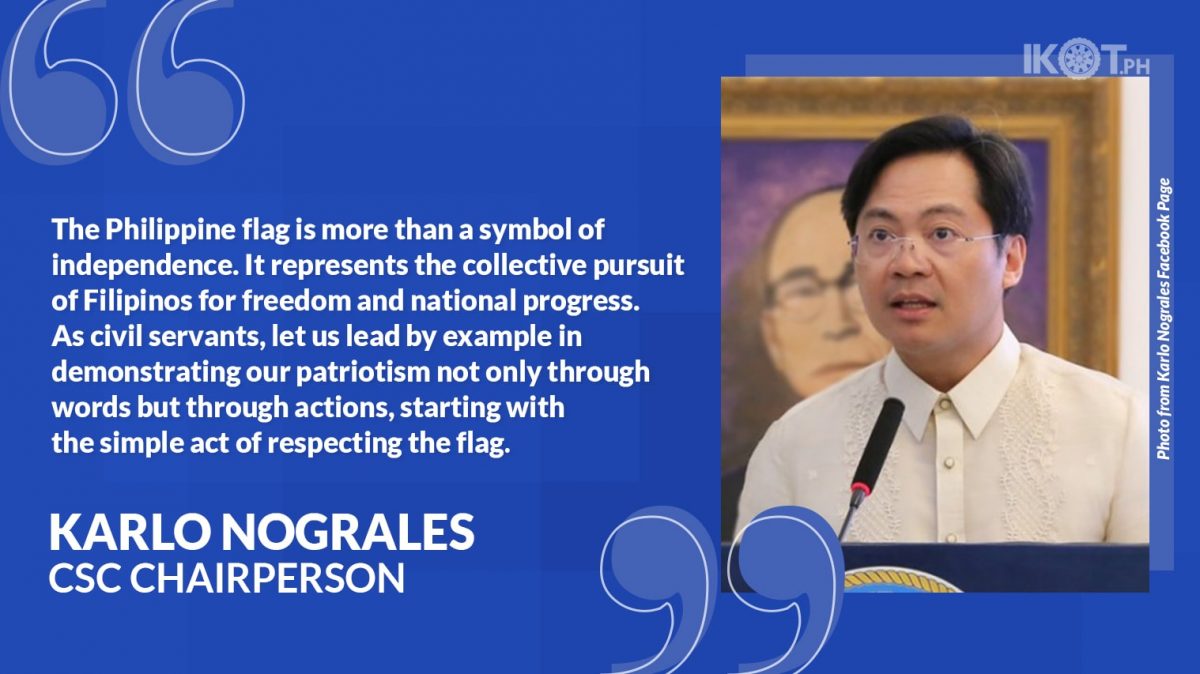The Civil Service Commission (CSC) called upon government officials and employees to manifest patriotism by honoring the Philippine flag in observance of the National Flag Days from 28 May to 12 June 2024.
CSC Chairperson Karlo Nograles reminded civil servants nationwide that the commemoration of the National Flag Days provides an opportune time for all Filipinos to collectively reflect on the significance of our National Flag.
Per Presidential Proclamation No. 374 s. 1965, 28 May of every year is declared as “National Flag Day” to commemorate the first unfurling of the flag after the Philippine Revolutionary Army defeated the Spanish forces in the Battle at Alapan, Imus, Cavite in 1898.
“The Philippine flag is more than a symbol of independence. It represents the collective pursuit of Filipinos for freedom and national progress. As civil servants, let us lead by example in demonstrating our patriotism not only through words but through actions, starting with the simple act of respecting the flag,” said Chairperson Nograles.
He further reminded government officials and employees of their sworn oath to follow the eight norms of conduct mandated under Republic Act (R.A.) No. 6713, or the Code of Conduct and Ethical Standards for Public Officials and Employees, which include “nationalism and patriotism.”
Under CSC Memorandum Circular No. 19, s. 2012, all government offices and educational institutions shall also observe the flag-raising ceremony every Monday morning, or the next working day if Monday is declared a holiday, and the flag lowering ceremony every Friday afternoon, or on the last working day of each week.
Chairperson Nograles also reiterated that under R.A. No. 8491, or the Flag and Heraldic Code of the Philippines, “reverence and respect shall at all times be accorded the flag, the anthem and other national symbols which embody the national ideals and traditions, and which express the principles of sovereignty and national solidarity.”
R.A. No. 8491 states that the flag shall be displayed in all public buildings, official residences, public plazas, and institutions of learning every day throughout the year. The flag ceremony shall be simple and dignified and shall include the playing or singing of the Philippine National Anthem, with the assembly standing in formation facing the flag.
The moment the first note of the anthem is heard, everyone in the premises shall come to attention and place their right palms over their chests; moving vehicles shall stop; those with hats shall uncover; while those in military, scouting, security guard, and citizens military training uniforms shall give salute prescribed by their regulations.
Additionally, the law forbids any act or omission that mutilates, tramples, or casts dishonor or ridicule upon the flag. Using the flag as tablecloth, drapery, or covering for ceilings, statues, and other objects; displaying the flag under any painting or picture or below any platform; as well as wearing the flag, in whole or in part, as a costume or uniform, is not allowed. The law also prohibits adding any word, figure, mark, design picture, advertisement, drawing, or imprint of any nature on the flag.
Furthermore, R.A. No. 8491 also forbids printing, painting, or attaching representations of the flag on handkerchiefs, napkins, cushions, and other articles of merchandise or using and displaying the flag as part of any advertisement or infomercial.
Per Presidential Proclamation No. 374 s. 1965, 28 May of every year is declared as “National Flag Day” to commemorate the first unfurling of the flag after the Philippine Revolutionary Army defeated the Spanish forces in the Battle at Alapan, Imus, Cavite in 1898.
On 23 May 1994, Executive Order No. 179 was issued extending the period of celebrating National Flag Day from 28 May to 12 June. During this period, all offices, agencies, and instrumentalities of government, business establishments, learning institutions, and private homes are encouraged to proudly display the Philippine flag.



